At a glance, you might assume that the painting below is a true Renaissance-era work, but you would be mistaken. While passable for a priceless 21st-century masterpiece, “The Boy With Apple” by Michael Taylor is, in fact, just a movie prop and was commissioned for Wes Anderson’s academy award-winning movie The Grand Budapest Hotel.
Though it’s not a real renaissance painting, its cinematic debut created a stir within the viewing audience, a strong need to own a copy or learn more about the “famous” work of art.
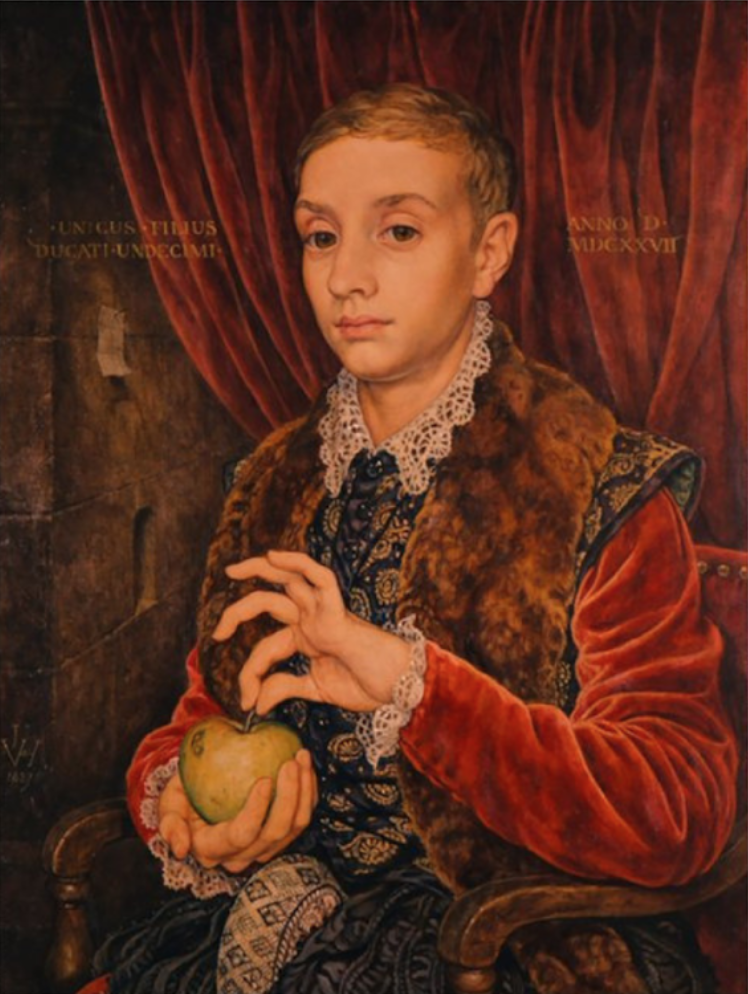
Fun Fact: The model for the portrait was actor Ed Munro.
Attention To Detail
If Anderson is known amongst his peers and fans for one thing it certainly is the amount of detail he puts into every film he works on. For example, in 2012, British artist Michael Taylor was commissioned by Anderson to create this faux Renaissance-era portrait that would evoke imagery from European art history, but Anderson’s eye for detail for this painting didn’t stop there. He actively added his own input to the work and asked that the painting follow the creative style of Hans Holbein the Younger and Elder, Bronzino, Lucas Cranach the Elder, and a number of Flemish and Dutch painters. Now, that may seem a lot to ask of an artist, some may even call this level of detail annoying, but once again, the level of detail doesn’t stop there.
The same amount of detail was also given to the painting’s backstory. In the movie, this painting is attributed to the fictional “Johannes Van Hoytl the Younger” and is described as being in the style of a “Czech mannerist, Habsburg high Renaissance, Budapest neo-humanist.”
Though it is only briefly mentioned, detail and backstory are incredibly important to Anderson’s storytelling and directing style, so we wanted to dive a little deeper into Anderson’s compulsive need for control and detail, and to explore the art that comes from it.
Who is Wes Anderson and How Does He Do It?
As I’m sure you’ve guessed, Wesley (Wes) Wales Anderson is an American filmmaker known for his distinctive visual and narrative styles, often being described by critics as a modern-day auteur.
Part of Anderson’s allure is what some refer to as “direct-directing”, or in other words, highly detailed and fully realized stories, characters, sets, and scenes. Everything the audience sees on the screen is done with meticulous attention making for a truly captivating film experience. That being said, Wes is heavily involved with the production and the final product of the movie.
According to those who have worked with him, symmetry, accommodative set design, and attentive framing are incredibly important when working with him. Cinematographer Robert Yeoman, who has worked with Wes on upwards of seven films says that prep work and planning, better known as “pre-production”, is incredibly important to Anderson.
In fact, while working on The Grand Budapest Hotel the two spent time in Paris, Prague and Germany doing observations (which, really, doesn’t sound half bad.)
Another practice Wes frequently engages in is creating “animatics”, or mock-ups of the scene in which he voices all the characters and plans the positioning/blocking of the scene. Since Wes is so particular with framing, Robert recalls numerous occasions on which scenes would be reshot over and over again due to a change in position of less than an inch! #dead
One of the interesting things about Anderson’s work is, even if you don’t know who Wes Anderson is or you weren’t aware you were watching one of his films, his films are easily identifiable due to key visual style choices, like bird’s-eye view shots, particularly-filmed slow-mos, recurring casts, whip pan shots and tilts.
And let’s not forget his world-building colour palettes designed for each film.
In addition to careful symmetry, framing, and pre-production, another way that Anderson’s films stand out is through the carefully selected short-range of similar and complementary colour palettes he creates for each film. These help set the tone and timing with the colour often speaking volumes about the characters’ personalities and intentions throughout.
Check out these examples!
Bottle Rocket, 1996
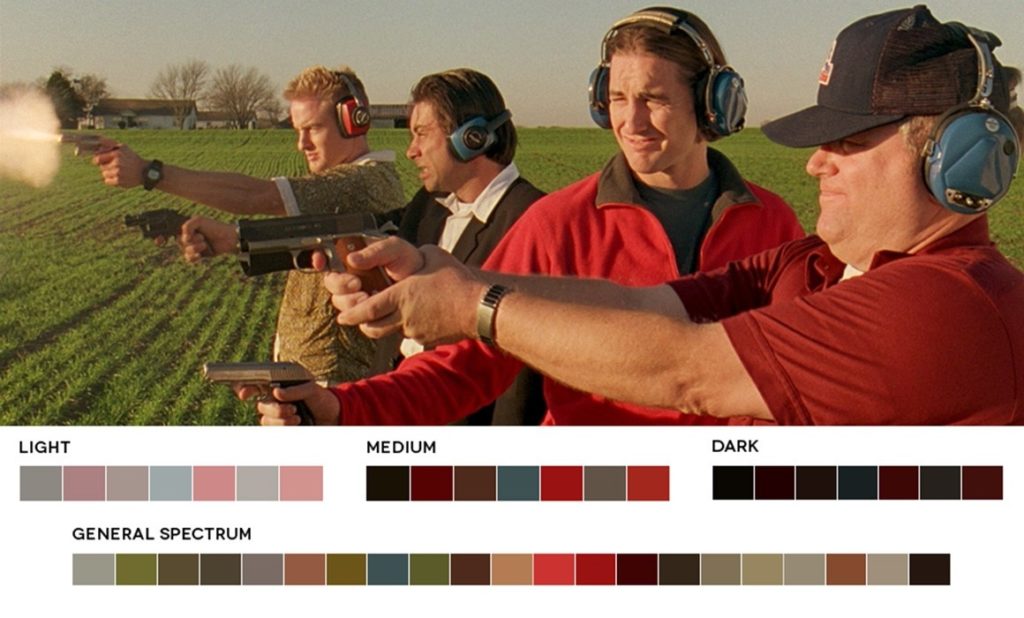
Rushmore, 1998
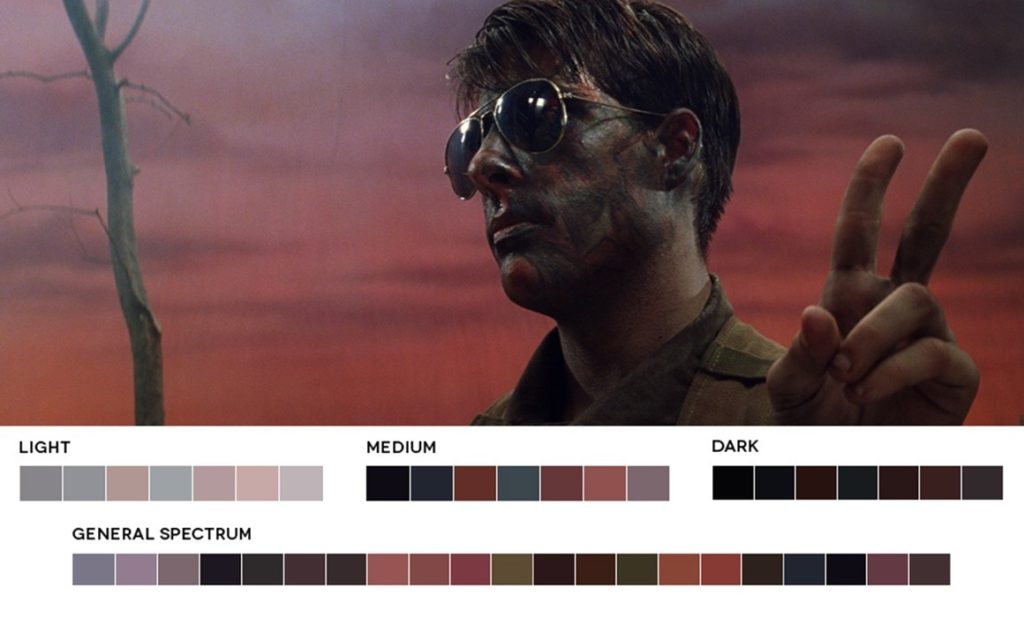
The Life Aquatic, 2004
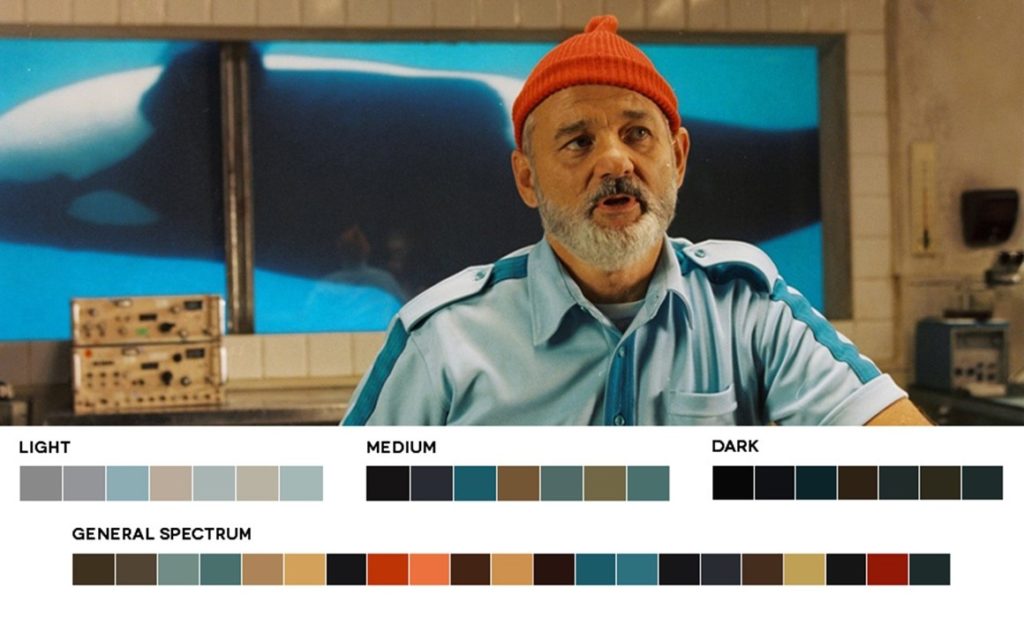
The Darjeeling Limited, 2007
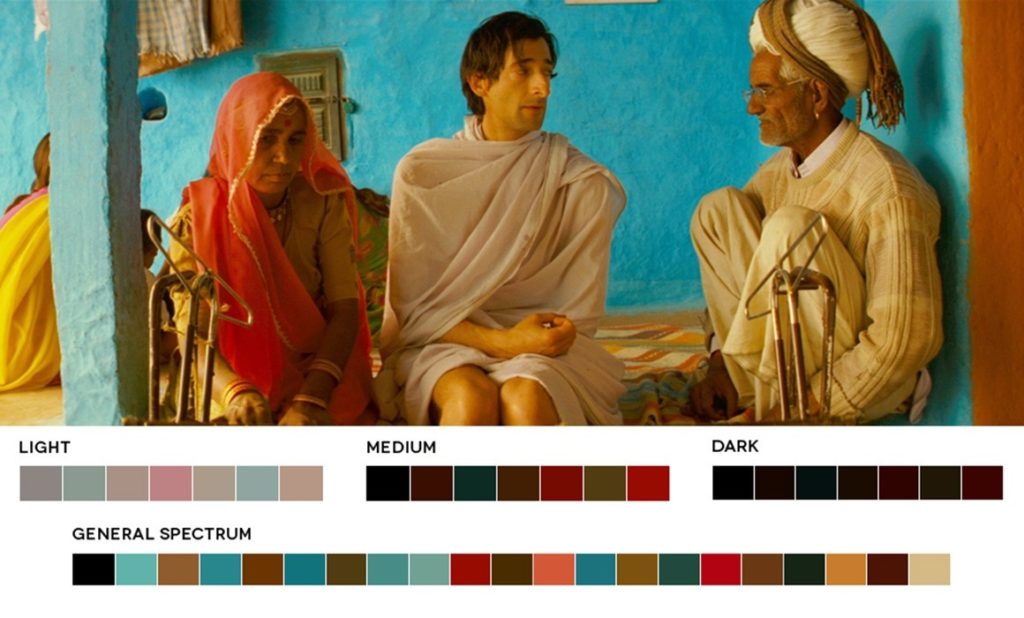
Fantastic Mr. Fox, 2009
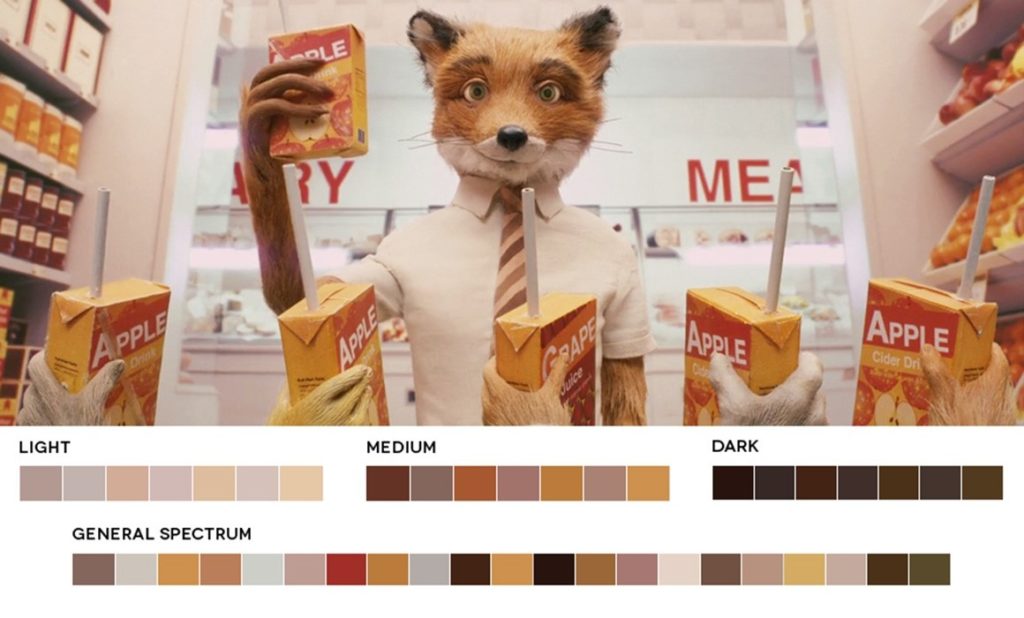
Moonrise Kingdom, 2012
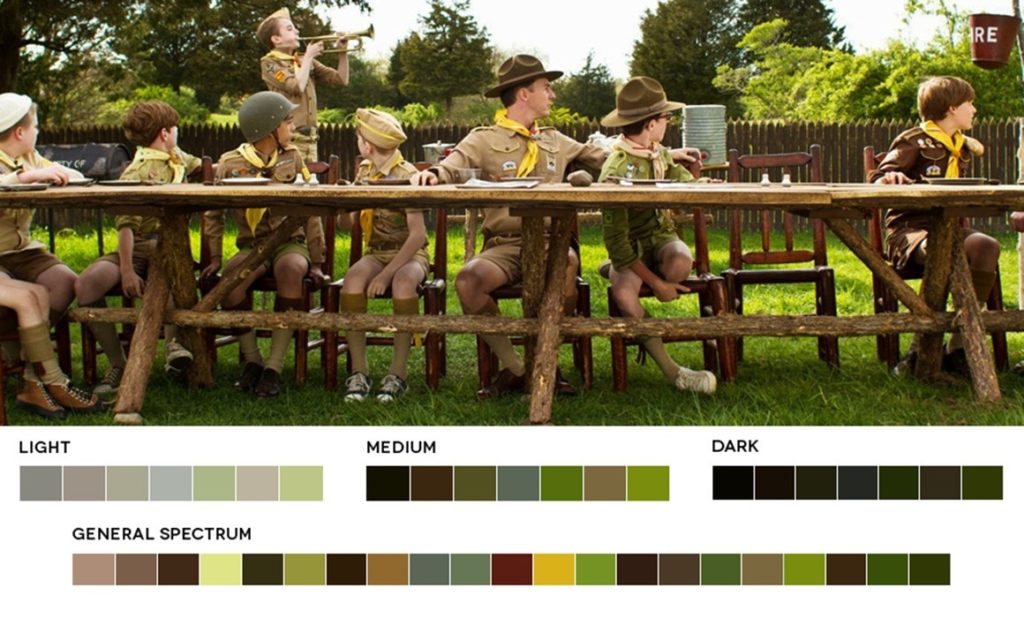 You may notice in the colour swatches that there is a recurring colour ”pattern” present, with blue/green, yellow/orange/beige, and red/pink showing up in every swatch. The colours are also relatively muted and contrasting to one another, however, collectively, they still have a cohesive quality to them making each scene aesthetically pleasing.
You may notice in the colour swatches that there is a recurring colour ”pattern” present, with blue/green, yellow/orange/beige, and red/pink showing up in every swatch. The colours are also relatively muted and contrasting to one another, however, collectively, they still have a cohesive quality to them making each scene aesthetically pleasing.
Like many directors, Wes also has a handful of actors and actresses who he commonly has assuming the leading roles in his films. Some, to name a few, include; Bill Murray, Owen Wilson, Juke Wilson, Jeff Goldblum, Jason Schwartzman, Adrien Brody, and Anjelica Huston. Fun fact: Bill Murray has starred in a total of 9 roles, for Anderson filmed between 1998 and 2020.
Moreover, in addition to an impressive career in film, Anderson has also dabbled in advertising. Some of the brands who he has worked with are; IKEA, Hyundai, AT&T, Prada, and more! For example, unique style can be seen particularly in the 2016 “Come Together” campaign he shot for the popular fashion brand H&M.
Alternatively, a commercial he made for the credit card company American Express almost pokes at his incredibly diverse movie career and attention to detail.
In particular, the blocking, framing and lateral camera movements really give both of these commercials their signature Anderson feel. In addition, the advertisements star members from the dream team: Adrien Brody as the train conductor and Jason Schwartzman as one of the actors.
Wesley Wales Anderson has had a remarkable career, and with 13 films under his belt and a massive fan following, he has earned his place on the list of today’s greatest directors. From his first film, “Bottle Rocket” (1996), to his most recent endeavour, “The French Dispatch” (2020), each of his movies has a unique Anderson feel to them. Meticulous attention to detail, stunning colour palettes, distinctive framing techniques and recurring faces all lend to this allure, whether it be a full-length feature film, a short film, or a commercial.
While “The Boy With Apple”, may not be a “real” piece of art, the movie it came from and the creative minds behind it certainly are.